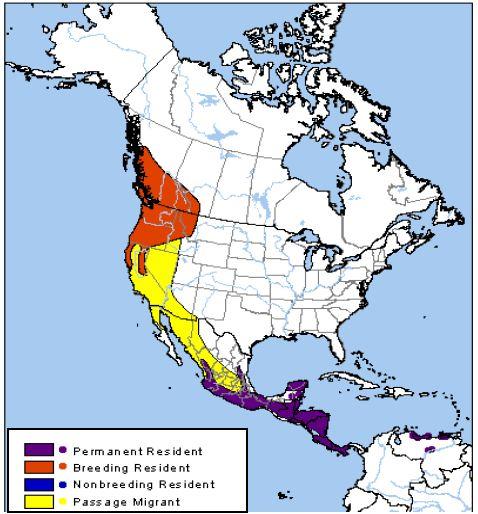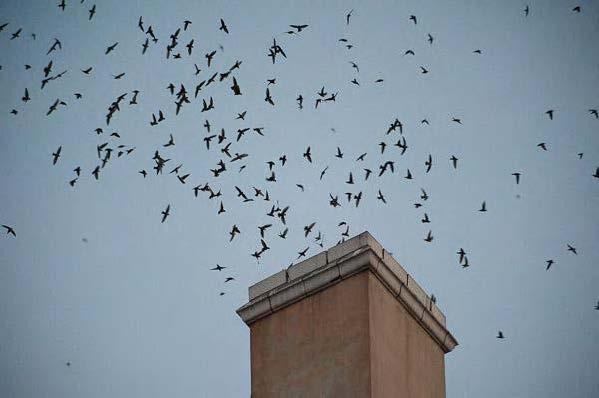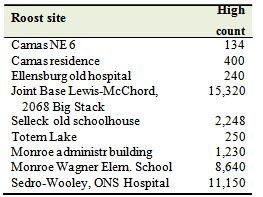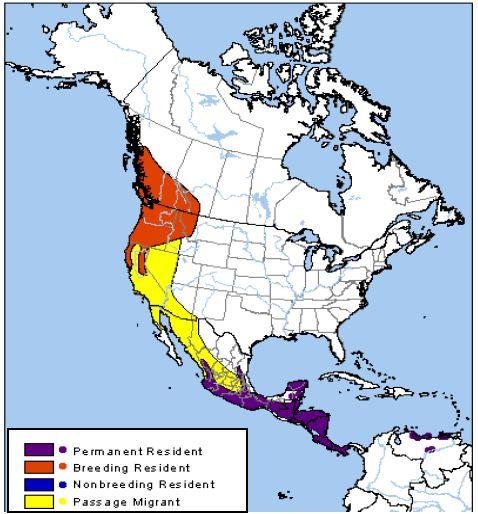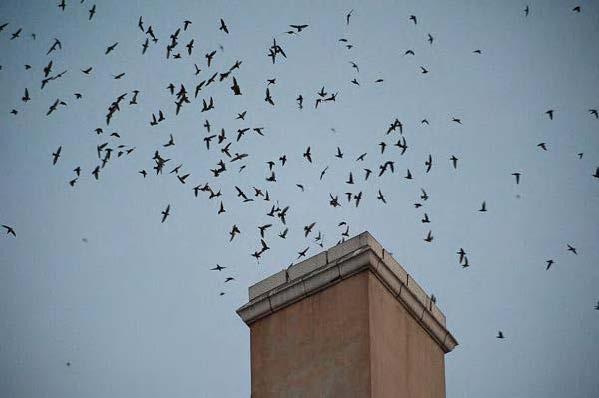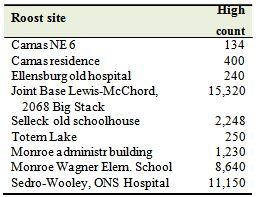Vaux's Swift (Chaetura vauxi)
This article was originally published by the Washington Department of Fish and Wildlife as part of its annual report Threatened and Endangered Wildlife in Washington.

State Status: Candidate, 1991
Federal Status: None
Recovery Plans: None
Vaux’s swifts (Figure 1), known for their aerobatic flying abilities, breed from southeastern Alaska to central California, and inland to western Montana (Figure 2). Resident populations also exist in Mexico and Central America. The species winters from central Mexico to Central America and Venezuela (Bull and Collins 1993).
Vaux’s swifts are present in Washington as spring and autumn migrants and as summer residents. Migration occurs from late April to late May and again from mid-August to late September. During the breeding season, the species is mainly associated with old-growth and mature forests in western Washington, the eastern Cascades, northeastern Washington, and the Blue Mountains (Smith et al. 1997, Lewis and Nordstrom 2005).
Vaux’s swifts spend most of their day in the air foraging for flying insects, which they pursue and capture in their beak. Foraging occurs over forests, grasslands, and aquatic habitats (Bull and Beckwith 1993). After nestlings hatch, adults collect boluses of insects in their mouths that are brought to the nest for feeding the young. Boluses examined in the Blue Mountains in Oregon contained mainly leafhoppers, flies, mayflies, and flying ants (Bull and Beckwith 1993). Adults forage mostly within a quarter mile of the nest when young are present.
Vaux’s swifts have short legs and tiny weak feet, and rarely perch on tree limbs. Instead, they usually cling to rough vertical surfaces when roosting.
Habitat. Vaux’s swifts are strongly associated with old-growth coniferous forests, where the insides of large hollow trees and snags are frequently used for nesting and roosting (Bull and Cooper 1991, Huff and Raley 1991, Lundquist and Mariani 1991, Manuwal 1991, Bull and Collins 1993, Bull and Hohmann 1993, Bull and Blumpton 1997). Characteristics of old-growth forest stands (e.g., age, canopy layering, stem density) do not appear to be as important as the availability of nesting and roosting trees (Bull and Hohmann 1993). Nests are often placed in hollow trees used by roosting pileated woodpeckers (Dryocopus pileatus), with swifts entering these trees through woodpecker holes. Without these excavations, Vaux’s swifts would have no access to many hollow tree chambers (Bull and Collins 1993, Sterling and Paton 1996).
Chimneys are also occasionally used as nest sites, with older brick chimneys preferred. One nest per chimney is typical, but up to five nesting pairs per chimney have been noted (Griffee 1961, Baldwin and Zaczkowski 1963, Bull and Collins 1993).
Vaux’s swifts commonly gather at large communal roosts during spring and fall migration along the West Coast. These roosts are typically located in large old brick chimneys, but large hollow trees and snags are also used. At least 25 of these sites are known in Washington (15 in western Washington, 11 in eastern Washington) (Vaux’s Happening, http://www.vauxhappening.org/Vauxs_Happening_Home.html). The most active of these during fall 2012 were in chimneys at Joint Base Lewis-McChord (this had the second largest count of any roost on the West Coast), Sedro-Wooley, and Monroe (Table 1).
Factors affecting populations. The strong connection of Vaux’s swifts to old-growth forests, where breeding season population densities are highest, suggests that the availability of this habitat and its associated features (e.g., large hollow trees and snags) limits the species’ distribution and abundance (Bull and Hohmann 1993). Population declines during the 1970s and 1980s were probably related to the continued logging of these forests (Bull and Collins 1993).
Brick chimneys have also become less common and accessible to swifts during recent decades as chimney styles change and many are covered with screen spark-arresters (Bull and Collins 1993). The reduced availability of chimneys suitable for nesting and roosting may affect population sizes in some areas and overall migration patterns.
Conservation actions. Since 2008, Audubon’s Vaux's Happening has been assembling information and organizing counts of migrating Vaux’s swifts across much of the species’ North American range by contacting biologists, birdwatchers, and interested citizens from Alaska to Mexico (http://www.vauxhappening.org/Vauxs_Happening_Home.html ). This effort has discovered additional important migration roosts, including a chimney on Joint Base Lewis-McChord.
Audubon chapters and community efforts have helped protect several important migration roosts in Washington. One such site is the chimney at Frank Wagner Elementary School in Monroe, which the Monroe School District had been considering for removal because of safety concerns. Audubon began working to save the chimney after counts revealed large numbers of swifts using it in spring and fall. The school district responded positively and protected the chimney in about 2009. Monroe Swift Night Out has become an annual fall event at the school and is attended by hundreds of people interested in watching the swifts come to roost.
The Vaux’s Swiftcam was established at Wagner Elementary School in 2010 to help inform the public about Vaux’s swifts and their conservation by streaming video to the Internet. The camera was developed by Larry Schwitters, project coordinator for Vaux’s Happening, with funding from WDFW and assistance from many supporters and partners.
WDFW published Priority Habitat and Species Management recommendations for Vaux’s swift in 2002 (Lewis et al. 2002). These give information on protecting and maintaining large hollow trees, snags, and brick chimneys, and reducing the use of insecticides near swift populations.
Partners and cooperators: Monroe Swift Watch, Pilchuck Audubon Society, Eastside Audubon Society, Seattle Audubon Society, Vaux’s Happening, Larry Schwitters, Progressive Animal Welfare Society (PAWS), Monroe School District, Monroe Correctional Complex, many others.
Literature Cited
Baldwin, P., and N. Zaczkowski. 1963. Breeding biology of the Vaux’s swift. Condor 65:400-406.
Bull, E. L., and R. C. Beckwith. 1993. Diet and foraging behavior of Vaux’s swift in northeastern Oregon. Condor 95:1016-1023.
Bull, E. L., and A. K. Blumton. 1997. Roosting behavior of postfledgling Vaux’s swift in northeastern Oregon. Journal of Field Ornithology 68:302-305.
Bull, E. L., and C. T. Collins. 1993. Vaux’s swift (Chaetura vauxi). Number 77 in A. Poole and F. Gill, editors. The Birds of North America. Academy of National Science and American Ornithologists’ Union, Philadelphia, Pennsylvania.
Bull, E. L., and H. D. Cooper. 1991. Vaux’s swift nests in hollow trees. Western Birds 22:85-91.
Bull, E. L., and J. E. Hohmann. 1993. The association between Vaux’s swifts and old growth forests in northeastern Oregon. Western Birds 24:38-42.
Griffee, W. E. 1961. Nesting of the northern Vaux’s swift in the Willamette Valley. Murrelet 42:25-26. Huff, M. H., and C. M. Raley. 1991. Regional patterns of diurnal breeding bird communities in Oregon and Washington. Pages 177-205 in L. Ruggiero, K. B. Aubry, A. B. Carey, and M. H. Huff, editors. Wildlife and vegetation of unmanaged Douglas-fir forests. USDA Forest Service General Technical Report PNWGTR-285, Portland, Oregon.
Lewis, J. C. and N. Nordstrom. 2005. Vaux’s swift. Pages 227-228 in T. R. Wahl, B. Tweit, and S. G. Mlodinow, editors. Birds of Washington: status and distribution. Oregon State University Press, Corvallis. Oregon. 436 pp.
Lewis, J. C., M. Whalen, and R. Milner. 2002. Vaux’s swift. Pages 25-1–25-5 in E. Larsen, J. M. Azerrad, N. Nordstrom, editors. Management recommendations for Washington’s priority species, Volume IV: Birds. Washington Department of Fish and Wildlife, Olympia, Washington. http://wdfw.wa.gov/publications/00026/
Lundquist, R. W., and J. M. Mariani. 1991. Nesting habitat and abundance of snag-dependent birds in the southern Washington Cascade Range. Pages 221-240 in L. Ruggiero, K. B. Aubry, A. B. Carey, and M. H. Huff, editors. Wildlife and vegetation of unmanaged Douglas-fir forests. USDA Forest Service General Technical Report PNW-GTR-285, Portland, Oregon.
Manuwal, D. A. 1991. Spring bird communities in the southern Washington Cascade Range. Pages 161-174 in L. Ruggiero, K. B. Aubry, A. B. Carey, and M. H. Huff, editors. Wildlife and vegetation of unmanaged Douglas- fir forests. USDA Forest Service General Technical Report PNW-GTR-285, Portland, Oregon.
Sauer, J. R., J. E. Hines, J. E. Fallon, K. L. Pardieck, D. J. Ziolkowski, Jr., and W. A. Link. 2011. The North American Breeding Bird Survey, results and analysis 1966 - 2009. Version 3.23.2011. USGS Patuxent Wildlife Research Center, Laurel, Maryland.
Smith, M. R., P. W. Mattocks, Jr., and K. M. Cassidy. 1997. Breeding birds of Washington State: location data and predicted distribution. In K. M. Cassidy, C. E. Grue, M. R. Smith, and K. M. Dvornich, editors. Washington State gap analysis - final report. Volume 4. Seattle Audubon Society Publications in Zoology No. 1, Seattle, Washington. 538 pp.
Sterling, J., and P. W. C. Paton. 1996. Breeding distribution of Vaux’s swift in California. Western Birds 27:30-40
Source: Washington Department of Fish and Wildlife. 2013. Threatened and Endangered Wildlife in Washington: 2012 Annual Report. Listing and Recovery Section, Wildlife Program, Washington Department of Fish and Wildlife, Olympia. 251 pp.


